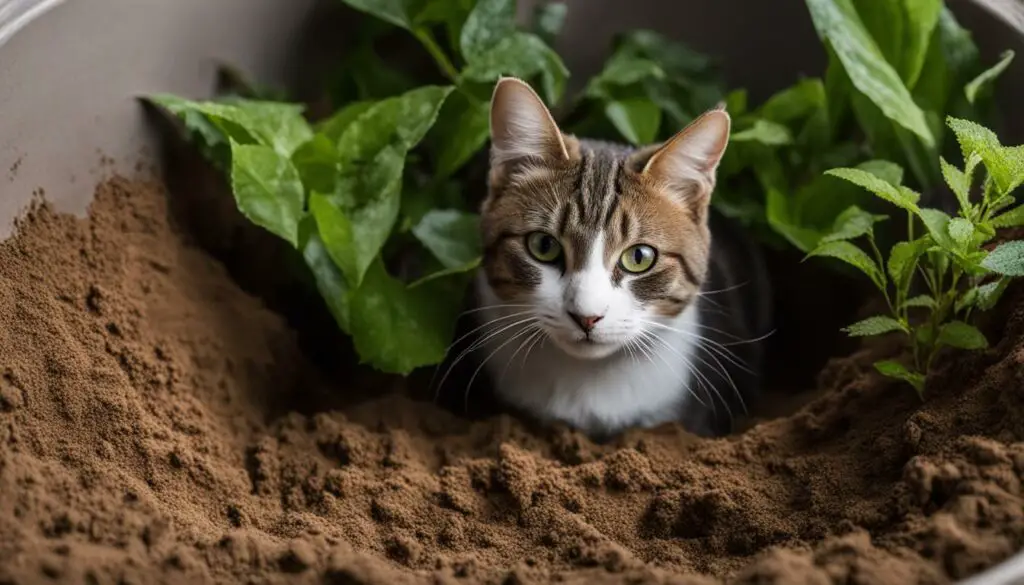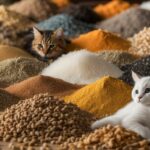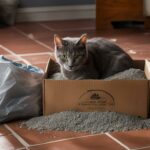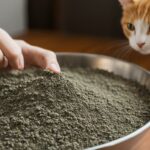As a cat owner, you may be wondering if you can use dirt as a natural alternative to traditional cat litter. In this article, I will explore the pros and cons of using dirt for cat litter, as well as alternative options that are more eco-friendly and sustainable. I will provide you with the information you need to make an informed decision for your feline friend.
Key Takeaways:
- Dirt can be used as cat litter, but it has limitations in terms of absorption and odor control.
- There are alternative cat litter options such as wood pellet litter and recycled paper/corn-based litters that provide better performance.
- Proper preparation and maintenance are essential when using dirt as cat litter.
- Health and safety considerations should be taken into account, as using dirt may pose potential risks for your cat.
- Exploring homemade cat litter recipes can offer cost-effective and customizable alternatives.
The Importance of Cat Litter
As a responsible cat owner, understanding the importance of cat litter is essential for your feline friend’s well-being. Cat litter serves several functions, making it a crucial part of your cat’s daily life.
Firstly, cat litter helps absorb liquid waste, ensuring a clean and hygienic environment for your cat. It prevents urine from pooling, reducing the risk of bacterial growth and odor. This absorption capability is especially important for cats who spend most of their time indoors.
Secondly, cat litter controls odors effectively. It traps and neutralizes unwanted smells, keeping your home smelling fresh and pleasant. This not only benefits you and your family but also contributes to your cat’s comfort and overall satisfaction.
Cat litter plays a vital role in maintaining your cat’s hygiene and comfort. It helps absorb liquid waste, control odors, and provide a comfortable surface for your cat to dig and bury their waste.
Lastly, cat litter provides a comfortable surface for your cat to dig and bury their waste. This mimics their natural behavior in the wild and enhances their overall comfort. A litter box with suitable cat litter encourages your cat to use it consistently, preventing accidents and promoting good litter box habits.
Overall, cat litter is not just a convenience for cat owners; it is an essential component in maintaining your cat’s hygiene and overall well-being. By understanding the importance of cat litter, you can make an informed decision when choosing the best litter option for your beloved feline companion.
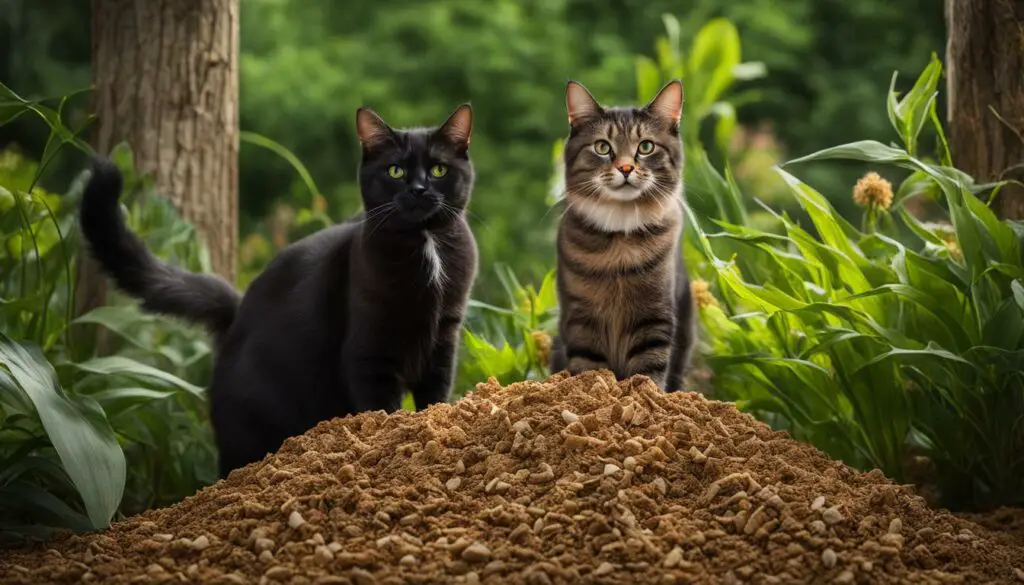
Types of Cat Litter
When it comes to selecting cat litter, there are a variety of options available in the market. Most commonly, cat owners choose from commercial cat litters like clay, silica gel, and clumping or non-clumping litters. These commercial options offer convenience and effective odor control. However, for those looking for more eco-friendly alternatives, there are natural and biodegradable options as well.
Natural cat litters are made from renewable materials such as wood pellets, recycled paper, or corn-based materials. These litters are not only more sustainable but also offer improved absorption and odor control. Wood pellet litters, for example, are highly absorbent and can form solid clumps for easy scooping.
In addition to commercial and natural options, there are also several DIY alternatives that cat owners can consider. These homemade litters can be made from shredded newspaper, wood shavings, or even sand. While homemade litters may require more effort to prepare, they can often be a cost-effective and customizable option for cat owners.
Comparison of Cat Litter Types
| Types of Cat Litter | Pros | Cons |
|---|---|---|
| Clay | – Excellent odor control – Easy to find and affordable |
– Environmental concerns – Heavy and dusty |
| Silica Gel | – Excellent odor control – Absorbs moisture well |
– Non-biodegradable – Can be irritating to cats’ paws |
| Wood Pellet | – Excellent absorption – Natural and biodegradable |
– May require more frequent changing – Tracking can be an issue |
| Recycled Paper | – Highly absorbent – Environmentally friendly |
– May need frequent replacement – Tracking can be an issue |
| Corn-Based | – Good clumping ability – Biodegradable |
– Some cats may not like the texture – Tracking can be an issue |
| DIY (Shredded Newspaper) | – Cost-effective – Customizable |
– Absorption may be lower – Odor control may be limited |
| DIY (Wood Shavings) | – Natural material – Can be a good option for outdoor cats |
– Tracking can be an issue – Limited availability |
| DIY (Sand) | – Affordable and readily available – Good odor control |
– Difficult to scoop waste effectively – Tracking can be an issue |
Ultimately, the choice of cat litter depends on your cat’s preferences and your own values. Consider factors such as odor control, absorption, sustainability, and your budget when making a decision. Experimenting with different types of cat litter may be necessary to find the best option for your feline companion.
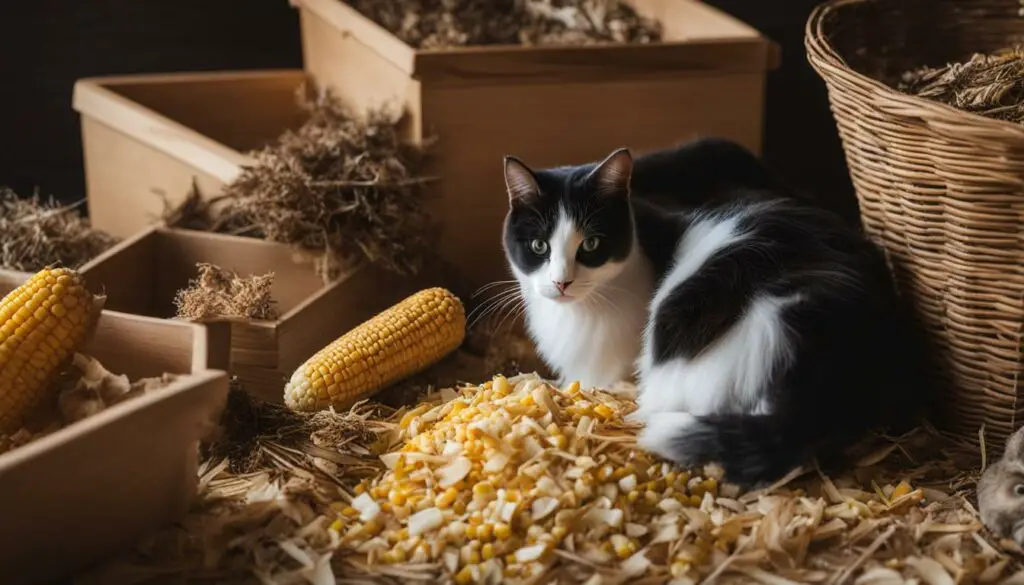
Using Dirt as Cat Litter
Using dirt as cat litter is a viable option for some cat owners, but it’s important to consider the pros and cons before making the decision. One of the advantages of using dirt as cat litter is its cost-effectiveness. Dirt is readily available and often free, making it an affordable choice for those on a budget. Additionally, dirt is a natural material, which may appeal to cat owners looking for a more eco-friendly option.
However, there are some drawbacks to using dirt as cat litter. One of the main disadvantages is its limited absorption capacity. Compared to commercial cat litters, dirt may not be as effective at controlling moisture and odors. This can result in a less sanitary and more unpleasant environment for both you and your cat. Additionally, dirt may be more challenging to clean and maintain, as it can easily become muddy or clumpy when wet.
When considering using dirt as cat litter, it’s important to note that not all types of dirt are suitable. Topsoil, sand, and clay soil are commonly used for this purpose. Topsoil is a nutrient-rich option that can provide a natural environment for your cat. Sand offers good absorption and odor control, but it may track more easily. Clay soil, on the other hand, can be dusty and may not be the most comfortable option for your cat’s paws.
Pros and Cons of Using Dirt as Cat Litter
| Pros | Cons |
|---|---|
| Cost-effective | Limited absorption |
| Natural and eco-friendly | Poor odor control |
| Challenging to clean and maintain |
Ultimately, the decision to use dirt as cat litter depends on your personal preferences and priorities. If you value affordability and natural materials, dirt may be a suitable choice for you. However, if you prioritize effective odor control and ease of maintenance, commercial cat litters or other natural alternatives may be more suitable. Consider your cat’s comfort and hygiene needs when making the decision, and don’t hesitate to consult with your veterinarian for further guidance.
Natural and Biodegradable Alternatives to Dirt
If you’re looking for a more effective and environmentally friendly alternative to using dirt as cat litter, there are several options available. These natural and biodegradable alternatives provide better absorption and odor control, ensuring a cleaner and more comfortable litter box for your feline friend.
Wood Pellet Litter
Wood pellet litter is an excellent alternative to dirt as it is made from compressed sawdust or wood shavings. It is highly absorbent, effectively controlling moisture and odors. This type of litter is also biodegradable, making it an eco-friendly choice. Additionally, wood pellet litter is dust-free, reducing the risk of respiratory issues for both you and your cat.
Recycled Paper or Corn-Based Litters
Recycled paper or corn-based litters are another great option for those seeking natural alternatives. These litters are made from recycled materials and provide excellent odor control. They are highly absorbent and clump well, making it easier for you to clean the litter box. Both recycled paper and corn-based litters are biodegradable and eco-friendly.
When considering natural and biodegradable alternatives to dirt, it’s important to choose a litter that meets your cat’s needs and preferences. Factors such as absorption, odor control, and eco-friendliness should be taken into account to ensure the well-being of your cat and the sustainability of the environment.
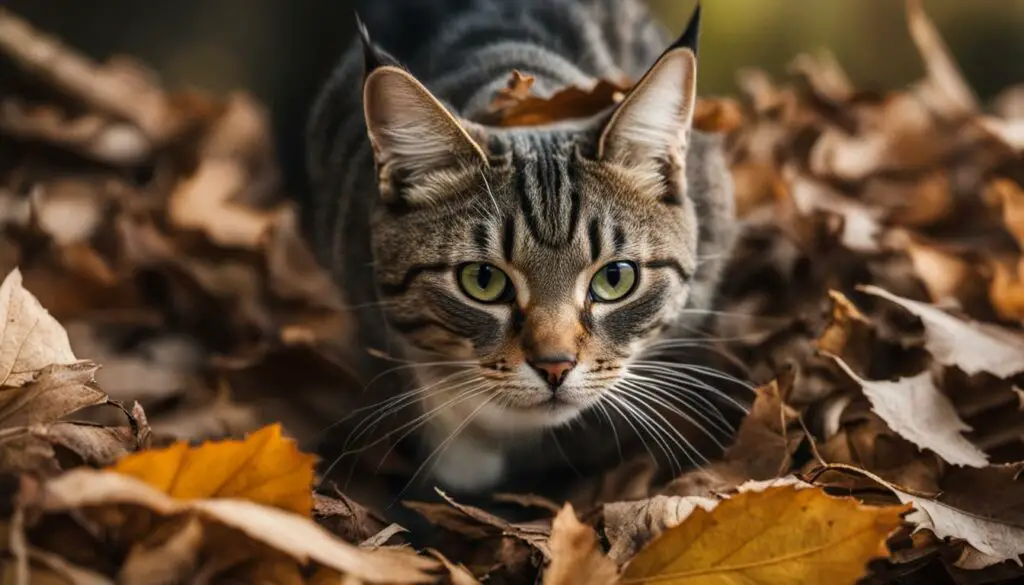
| Litter Type | Advantages | Disadvantages |
|---|---|---|
| Wood Pellet Litter | Highly absorbent, excellent odor control, biodegradable | May be more expensive than traditional litter |
| Recycled Paper Litter | Good odor control, highly absorbent, biodegradable | May not clump as well as other litters |
| Corn-Based Litter | Effective odor control, highly absorbent, biodegradable | May be more expensive than traditional litter |
By choosing natural and biodegradable alternatives to dirt, you can create a healthier and more sustainable environment for your cat. These options offer improved absorption, odor control, and eco-friendliness compared to using dirt as cat litter. Consider your cat’s needs and your own preferences when selecting the most suitable option for your furry companion.
Preparing and Using Dirt as Cat Litter
If you have decided to use dirt as cat litter, it is important to follow the proper preparation steps to ensure a clean and hygienic environment for your cat. Here are some step-by-step instructions to guide you:
- Start by collecting clean and chemical-free dirt or soil. Make sure to avoid soil that may contain harmful substances or pesticides.
- Fill a litter box with the dirt, ensuring a depth of at least two inches. Cats prefer a deeper litter box to allow for digging and burying their waste.
- Scoop the litter box regularly to remove solid waste. It is recommended to scoop the litter box at least once or twice a day to maintain cleanliness and prevent odors.
- Replace the dirt completely every one to two weeks or as needed. This will help prevent bacterial buildup and maintain a fresh environment for your cat.
- Keep an eye on any signs of discomfort or irritation in your cat. If you notice any negative reactions or health issues, it may be necessary to switch to a different type of litter.
Maintaining dirt as cat litter requires consistent upkeep to ensure your cat’s comfort and overall well-being. Here are a few additional tips to consider:
- Increase the depth of the litter box if your cat prefers a deeper substrate for digging.
- Place a mat or tray under the litter box to catch any excess dirt that may be tracked outside the box. This will help minimize mess and make cleaning easier.
- Consider adding a layer of baking soda to absorb odors. Sprinkling a thin layer of baking soda on top of the dirt can help control any unpleasant smells.
- Regularly clean and sanitize the litter box. Empty the contents, wash the box with mild soap, and rinse thoroughly before refilling with fresh dirt.
By following these guidelines, you can ensure a clean and comfortable litter box environment for your cat when using dirt as cat litter.
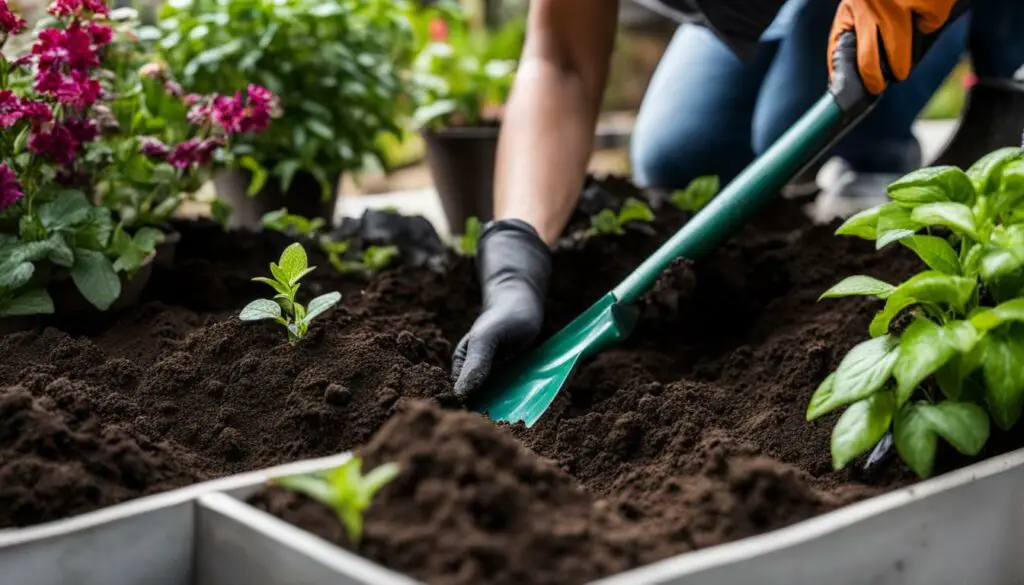
Additional Considerations for Using Dirt as Cat Litter
“Using dirt as cat litter may not provide the same level of odor control and absorption as commercial cat litters. It is important to monitor your cat’s litter box regularly and address any potential issues.”
While dirt can be a cost-effective and natural option, it may not be suitable for all cats or households. Some cats may be more sensitive to the texture or smell of dirt, and the limited absorption capabilities may lead to increased odors and mess. It is essential to monitor your cat’s litter box usage and address any concerns promptly.
It is also important to remember that dirt may not be as effective at controlling bacterial growth and parasites compared to commercial cat litters. Regular cleaning and maintenance of the litter box are crucial to prevent any potential health risks for your cat.
Table: Pros and Cons of Using Dirt as Cat Litter
| Pros | Cons |
|---|---|
| Natural and cost-effective option | Limited absorption capacity |
| Environmentally friendly | Poor odor control |
| Readily available | Potential tracking outside the litter box |
| Increased risk of bacterial growth | |
| Potential for parasites |
Health and Safety Considerations
Using dirt as cat litter may seem like a natural and cost-effective option, but it is important to consider the potential health risks it poses for your feline friend. Monitoring your cat’s well-being is crucial when using dirt as cat litter, as it can harbor bacteria and parasites that may harm your pet.
Table: Health Risks of Using Dirt as Cat Litter
| Health Risks | Explanation |
|---|---|
| Bacterial Growth | Dirt can contain harmful bacteria, such as E. coli and Salmonella, which can cause infections and gastrointestinal issues in cats. |
| Parasites | Dirt may contain parasites like fleas, ticks, or worms, which can infest your cat and lead to various health problems. |
| Allergies | Cats may develop allergies to certain types of dirt, resulting in skin irritations and respiratory issues. |
To ensure the safety of your cat, it is recommended to regularly check for any signs of discomfort or illness. These could include changes in behavior, appetite, litter box habits, or physical symptoms like vomiting or diarrhea. If you notice any worrisome symptoms, it is important to consult with your veterinarian right away.
When using dirt as cat litter, it is crucial to maintain a clean litter box to minimize the risk of bacterial growth and parasitic infestation. Regularly scoop the litter box and replace the soiled dirt with fresh soil to keep the environment as sanitary as possible. Additionally, consider consulting with a veterinarian to discuss suitable alternatives that offer better hygiene and safety for your cat’s litter needs.
Homemade Cat Litter Recipes
If you enjoy taking a hands-on approach and prefer to make things yourself, there are homemade cat litter recipes that you can try. These recipes offer a cost-effective and customizable alternative to traditional cat litter options. Let me share with you a few DIY cat litter recipes using natural materials:
1. Shredded Newspaper Litter
This simple and eco-friendly recipe involves shredding old newspapers into small strips. The shredded newspaper acts as an absorbent material, helping to control odors. Place the shredded newspaper in your cat’s litter box and change it regularly for optimal cleanliness.
2. Wood Shavings Litter
Wood shavings can be an effective and affordable option for homemade cat litter. Look for untreated wood shavings from pet-safe woods like pine or aspen. These shavings provide good odor control and can be easily disposed of. Remember to change the litter regularly to maintain cleanliness.
3. Sand Litter
Sand can also be used as a homemade cat litter alternative. It offers excellent odor control and is readily available. Fill your cat’s litter box with clean, fine-grained sand and scoop out waste regularly. Keep in mind that sand may be more challenging to clean and dispose of compared to other homemade options.
These DIY cat litter recipes provide budget-friendly alternatives to commercial cat litter while allowing you to control the materials used. Experiment with different recipes and find the one that works best for you and your cat’s preferences. Always ensure that the homemade litter is comfortable and safe for your feline friend.
| DIY Cat Litter Recipe | Materials | Benefits |
|---|---|---|
| Shredded Newspaper Litter | Newspapers | Eco-friendly, cost-effective, good odor control |
| Wood Shavings Litter | Untreated wood shavings (pine or aspen) | Affordable, good odor control, easy disposal |
| Sand Litter | Clean, fine-grained sand | Excellent odor control, readily available |
Remember to monitor your cat’s comfort and well-being when using homemade cat litter. If you notice any signs of discomfort or health issues, consider switching to a commercial cat litter that meets your cat’s needs. Enjoy the process of creating your own cat litter and providing your furry friend with an eco-friendly and personalized experience.
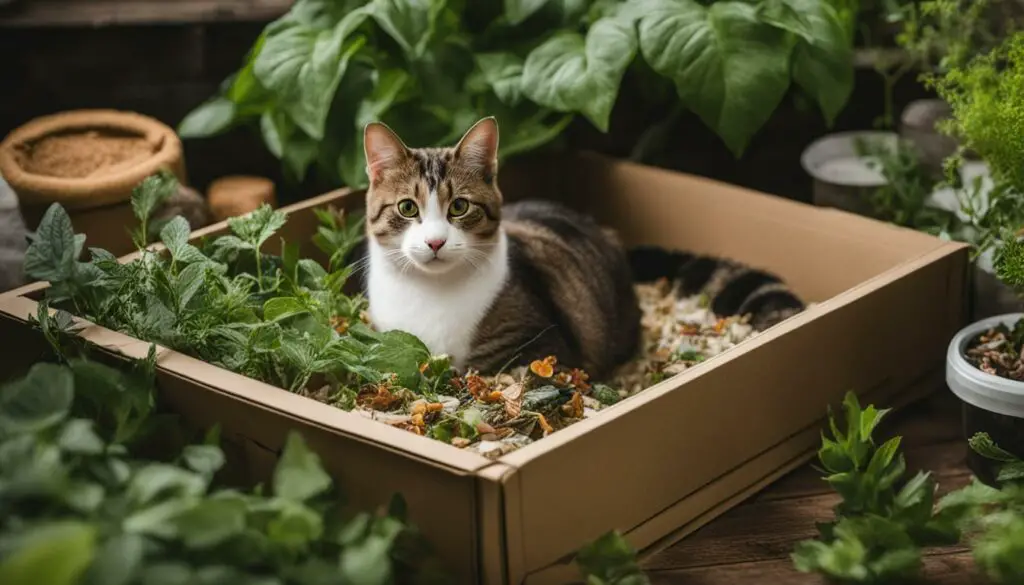
Making an Informed Choice
When it comes to choosing the right cat litter, it’s important to make an informed decision that takes into account your cat’s needs as well as your own preferences. There are several factors to consider, such as absorption, odor control, and eco-friendliness. By weighing these factors, you can select a cat litter that provides the best balance of functionality and convenience.
Factors to Consider
One of the key factors to consider when choosing cat litter is absorption. A good cat litter should be able to effectively absorb moisture, preventing it from pooling in the litter box and creating an unpleasant environment for your cat. It’s important to choose a cat litter that can handle your cat’s waste effectively, keeping it contained and minimizing the need for frequent cleanings.
Another factor to consider is odor control. Nobody wants their home to smell like a litter box, so opting for a cat litter that offers effective odor control is crucial. Look for a cat litter that is specifically designed to neutralize odors, keeping your home smelling fresh and clean.
Eco-friendliness is also an important consideration for many cat owners. There are cat litters available that are made from natural and biodegradable materials, helping to reduce your environmental impact. These eco-friendly options are often made from sustainable resources and are less harmful to the planet.
By considering these factors and weighing them against your cat’s specific needs, you can make an informed choice when selecting a cat litter. Remember to also consider your own preferences, such as cost-effectiveness and ease of use. With the wide variety of cat litters available on the market, you’re sure to find one that suits both you and your feline friend.
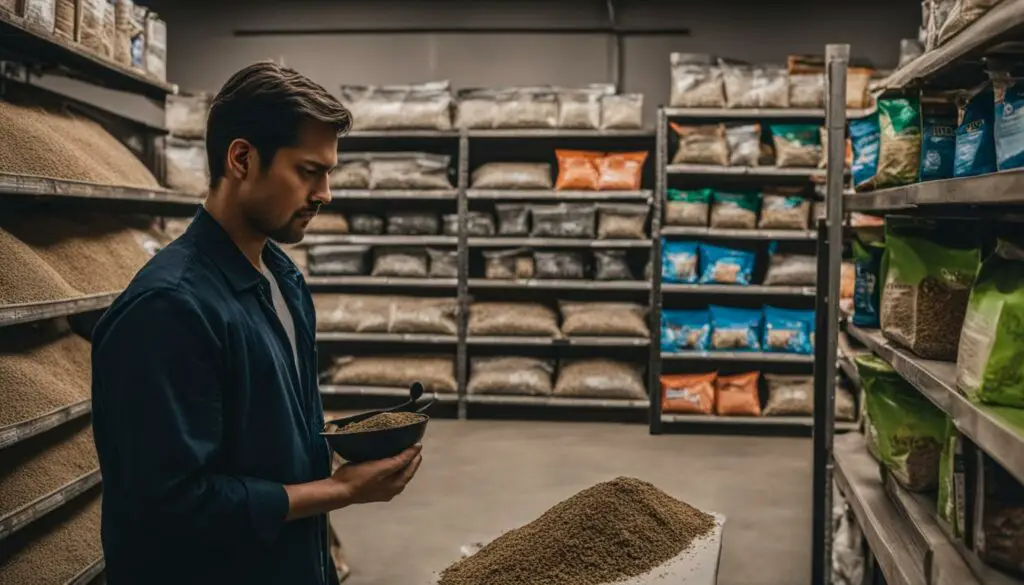
Is It OK to Use Soil in Cat Litter?
Using soil as cat litter is a topic that often comes up among cat owners seeking natural alternatives. While it may seem like a convenient and eco-friendly option, there are important factors to consider regarding the safety and effectiveness of using soil in your cat’s litter box.
Safety Concerns: One of the main concerns with using soil as cat litter is the potential presence of bacteria and parasites. Soil can contain harmful microorganisms that can pose health risks to your cat. Additionally, soil may not provide the necessary hygiene measures to prevent the growth of bacteria in the litter box.
Limited Odor Control: Unlike commercial cat litters, soil may not effectively control odors. The natural composition of soil can lead to unpleasant smells lingering in your home, which may impact your cat’s litter box experience and the overall comfort of your living space.
Alternative Options: Instead of using soil as cat litter, there are safer alternatives available. Natural and biodegradable options like wood pellet litter, recycled paper, or corn-based litters offer better absorption, odor control, and hygiene. These alternatives provide a more comfortable and pleasant environment for your cat while minimizing potential health risks.
Using soil as cat litter is generally not recommended due to hygiene concerns and limited odor control.
| Pros of Using Soil as Cat Litter | Cons of Using Soil as Cat Litter |
|---|---|
| – Cost-effective option | – Limited absorption |
| – Natural composition | – Poor odor control |
| – Readily available | – Potential bacterial growth |
When it comes to your cat’s well-being and the cleanliness of your home, it’s important to consider the potential risks and limitations of using soil as cat litter. By opting for safer and more effective alternatives, you can ensure a comfortable and healthy environment for your feline companion.
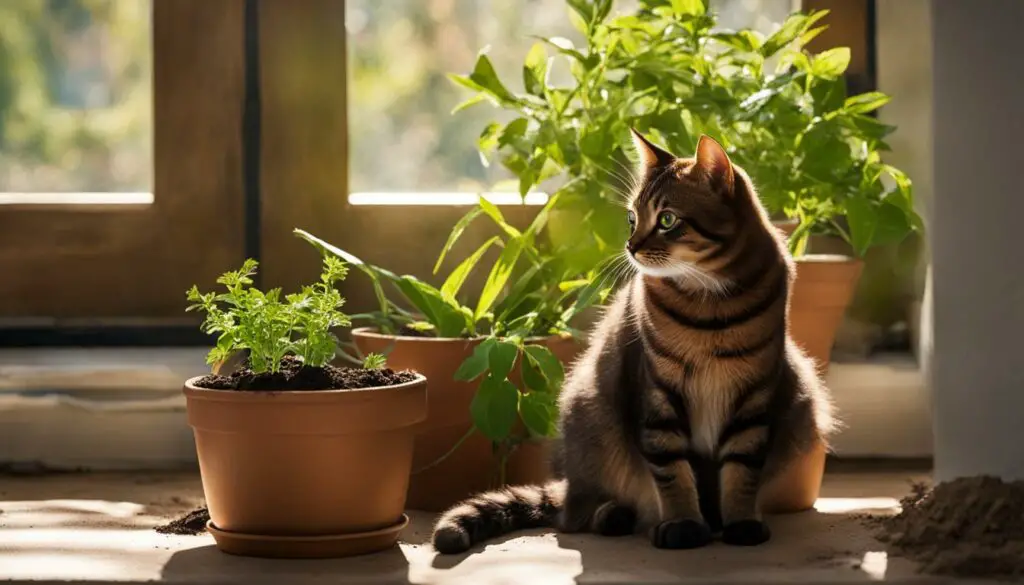
What Can I Use Instead of Cat Litter?
When looking for alternatives to traditional cat litter, there are several options to consider. These alternatives provide a more eco-friendly and sustainable solution for your cat’s litter needs. Here are some cat litter alternatives to explore:
1. Wood Pellet Litter:
Wood pellet litter is made from compressed sawdust or wood shavings. It is highly absorbent and effective in controlling odors. This type of litter is biodegradable and can be composted or used as mulch in your garden.
2. Recycled Paper Litter:
Recycled paper litter is made from recycled newspaper or cardboard. It is lightweight, dust-free, and has excellent odor control. This type of litter is biodegradable and can be composted.
3. Corn-Based Litter:
Corn-based litter is made from renewable corn sources. It is biodegradable, clumps well for easy cleaning, and has good odor control. This type of litter is also flushable, making it convenient for disposal.
These alternatives provide comparable or even better performance than traditional cat litter while minimizing environmental impact. Remember to gradually introduce any new litter to your cat to ensure they adapt well to the change. Monitor your cat’s behavior and comfort to make sure the alternative litter is suitable for them. Ultimately, the choice of cat litter alternative depends on your cat’s preferences and your own values.
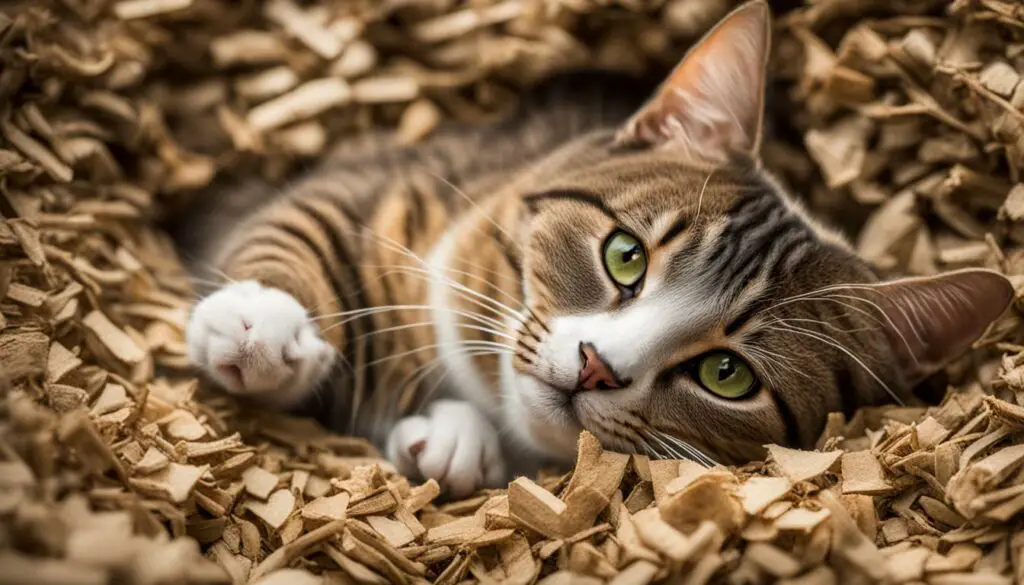
What Kind of Soil Is Used in Cat Litter?
If you’re determined to use soil as cat litter, it’s important to choose the right kind of soil that meets your cat’s needs. Unscented, chemical-free garden soil is generally considered suitable for cat litter. This type of soil provides a natural and comfortable surface for your cat to dig and bury their waste.
When selecting soil for cat litter, it’s crucial to sterilize it to eliminate any potential pathogens. Sterilization can be done by baking the soil in the oven at a temperature of 200 degrees Fahrenheit (93 degrees Celsius) for about 30 minutes. This process kills any bacteria or parasites that may be present, ensuring the safety and health of your cat.
While using soil as cat litter may be a viable option for some cat owners, it’s important to consider the limitations. Soil has limited absorption capabilities compared to commercial cat litters, which can lead to more frequent litter box changes and potential odor issues. Additionally, soil can be messy and may track more easily compared to other cat litter options.
| Pros of Using Soil as Cat Litter | Cons of Using Soil as Cat Litter |
|---|---|
| Cost-effective | Limited absorption |
| Natural composition | Poor odor control |
| Comfortable for cats | Potential tracking |
Overall, using soil as cat litter can be a natural and cost-effective option for cat owners. However, it’s important to consider the limitations and potential drawbacks. If you’re looking for alternatives that offer better absorption, odor control, and cleanliness, it may be worth exploring natural and biodegradable options such as wood pellet litter, recycled paper, or corn-based litters.
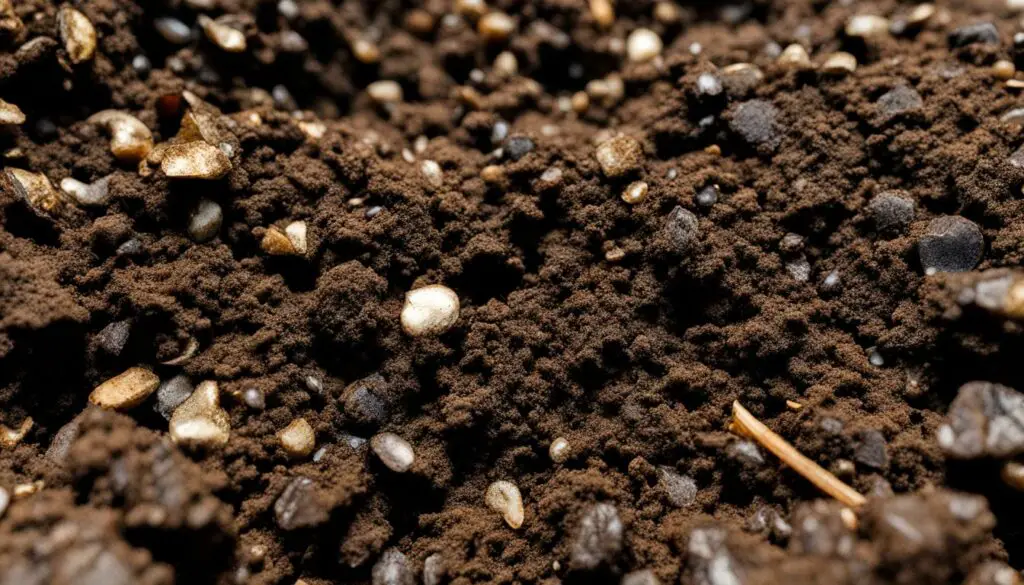
Key Takeaways:
- Unscented, chemical-free garden soil is generally suitable for cat litter.
- Sterilize the soil by baking it in the oven at 200 degrees Fahrenheit (93 degrees Celsius) for 30 minutes to eliminate potential pathogens.
- Soil has limited absorption capabilities and may not offer optimal odor control.
- Consider natural and biodegradable alternatives for better absorption, odor control, and cleanliness.
Can We Use Sand as Cat Litter?
Sand is a common material that cat owners often consider using as cat litter. Let’s explore the pros and cons of using sand as cat litter to help you make an informed decision for your furry friend.
The Pros of Using Sand as Cat Litter:
- Affordability: Sand is often more cost-effective than commercial cat litters, making it an attractive option for budget-conscious cat owners.
- Odor Control: Sand is known for its ability to absorb and mask odors effectively, helping to keep your home smelling fresh.
The Cons of Using Sand as Cat Litter:
- Tracking: Sand particles can easily stick to your cat’s paws and be tracked throughout your home, requiring more frequent cleaning to prevent messes.
- Waste Removal: Unlike clumping cat litters, sand does not clump, which can make waste removal more challenging and time-consuming.
Using sand as cat litter can be a viable option for some cat owners, especially those looking for a cost-effective and odor-controlling solution. However, it’s important to consider the potential drawbacks of sand, such as increased tracking and difficulty in waste removal.
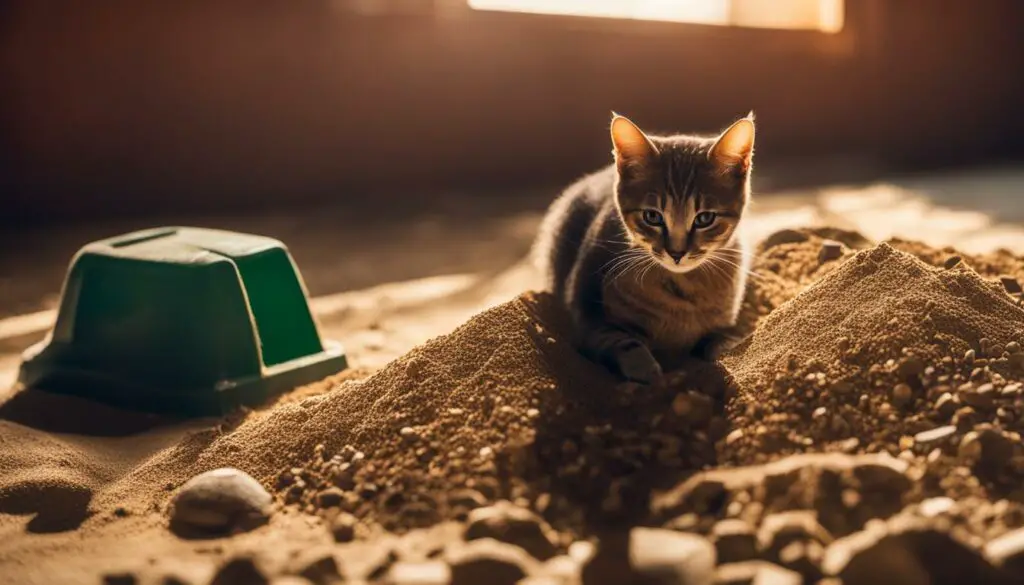
Ultimately, the decision to use sand as cat litter depends on your personal preferences and your cat’s needs. It’s essential to prioritize factors like affordability, odor control, and ease of maintenance when choosing the best litter for your feline companion.
| Pros of Using Sand as Cat Litter | Cons of Using Sand as Cat Litter |
|---|---|
| Affordability | Tracking |
| Odor Control | Waste Removal |
Conclusion
After exploring the pros and cons of using dirt as cat litter, it is clear that there are better alternatives available. While dirt may be cost-effective and natural, it falls short in terms of absorption and odor control. If you’re looking for a more effective and environmentally friendly option, consider natural and biodegradable alternatives such as wood pellet litter and recycled paper/corn-based litters.
By choosing these alternatives, you can ensure better absorption, superior odor control, and a more comfortable environment for your feline friend. Additionally, these options are eco-friendly and sustainable, helping to reduce your carbon footprint.
When deciding on the best cat litter for your pet, it’s essential to consider factors such as absorption, odor control, and eco-friendliness. By making an informed decision, you can provide your cat with the best possible litter box experience, keeping them happy and healthy.
FAQ
Can I use dirt as a substitute for cat litter?
While it is possible to use dirt as cat litter, there are several factors to consider. We’ll explore the advantages, such as its cost-effectiveness and natural composition, as well as the disadvantages, including limited absorption and poor odor control. We’ll also discuss different types of dirt, such as topsoil, sand, and clay soil, that can be used as cat litter.
What are some natural and biodegradable alternatives to dirt?
If you’re looking for a more effective and environmentally friendly alternative to dirt, there are options available. Wood pellet litter and recycled paper/corn-based litters are examples of natural and biodegradable alternatives that provide better absorption and odor control than dirt. We’ll explore these alternatives and discuss their features and benefits.
How do I prepare and use dirt as cat litter?
If you decide to use dirt as cat litter, proper preparation is crucial. We’ll provide you with step-by-step instructions on preparing the dirt and maintaining a clean and hygienic litter box. We’ll also share tips on managing odor control and tracking, ensuring a comfortable environment for your cat.
Are there any health and safety concerns when using dirt as cat litter?
Using dirt as cat litter may pose potential health risks for your cat. We’ll discuss the importance of monitoring your cat’s well-being and address potential concerns such as bacterial growth and parasites. It’s essential to ensure the safety and health of your cat when using dirt as cat litter.
Can I make my own cat litter at home?
If you prefer a DIY approach, there are homemade cat litter recipes you can try. We’ll provide you with step-by-step instructions on creating homemade alternatives using natural materials like shredded newspaper, wood shavings, or sand. These recipes offer cost-effective and customizable options for cat owners.
How do I make an informed choice for my cat’s litter?
Making an informed choice for your cat’s litter is important. We’ll summarize the key points discussed in this article, emphasizing the factors to consider when choosing cat litter, such as absorption, odor control, and eco-friendliness. This section will help you make an informed decision that meets your cat’s needs and your own preferences.
Is it safe to use soil as cat litter?
Using soil as cat litter is generally not recommended due to hygiene concerns and limited odor control. We’ll discuss the potential risks of using soil, including the presence of bacteria and the challenges of scooping waste effectively. While it’s possible to use soil in a pinch, we’ll explore safer alternatives for your cat’s litter box.
What are some alternatives to traditional cat litter?
If you’re looking for alternatives to traditional cat litter, there are options to consider. We’ll discuss natural and biodegradable litters like wood shavings and paper litter, as well as commercial cat litters that meet your cat’s needs. This section will help you explore alternatives that provide optimal absorption, odor control, and safety.
What kind of soil is suitable for cat litter?
If you’re determined to use soil as cat litter, certain types of soil are more suitable than others. We’ll discuss the characteristics of suitable soil, such as unscented, chemical-free garden soil, and the importance of sterilizing it to eliminate potential pathogens. Choosing the right kind of soil is essential for your cat’s safety and comfort.
Can I use sand as cat litter?
Sand can be used as cat litter, but it has its advantages and disadvantages. We’ll explore the pros, such as affordability and odor control, as well as the cons, including potential tracking and difficulties in waste removal. This section will provide you with a comprehensive understanding of using sand as cat litter.

